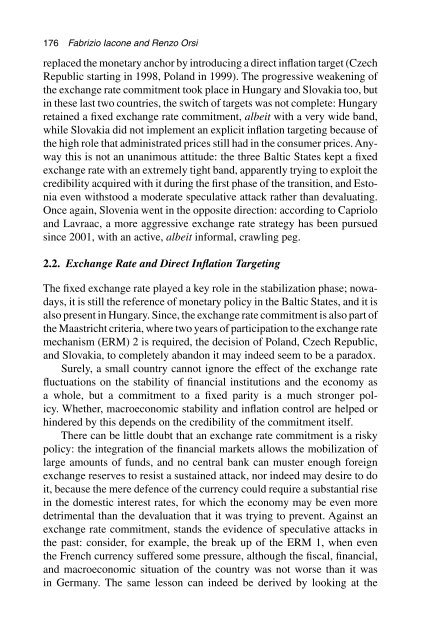Economic Models - Convex Optimization
Economic Models - Convex Optimization
Economic Models - Convex Optimization
You also want an ePaper? Increase the reach of your titles
YUMPU automatically turns print PDFs into web optimized ePapers that Google loves.
176 Fabrizio Iacone and Renzo Orsi<br />
replaced the monetary anchor by introducing a direct inflation target (Czech<br />
Republic starting in 1998, Poland in 1999). The progressive weakening of<br />
the exchange rate commitment took place in Hungary and Slovakia too, but<br />
in these last two countries, the switch of targets was not complete: Hungary<br />
retained a fixed exchange rate commitment, albeit with a very wide band,<br />
while Slovakia did not implement an explicit inflation targeting because of<br />
the high role that administrated prices still had in the consumer prices. Anyway<br />
this is not an unanimous attitude: the three Baltic States kept a fixed<br />
exchange rate with an extremely tight band, apparently trying to exploit the<br />
credibility acquired with it during the first phase of the transition, and Estonia<br />
even withstood a moderate speculative attack rather than devaluating.<br />
Once again, Slovenia went in the opposite direction: according to Capriolo<br />
and Lavraac, a more aggressive exchange rate strategy has been pursued<br />
since 2001, with an active, albeit informal, crawling peg.<br />
2.2. Exchange Rate and Direct Inflation Targeting<br />
The fixed exchange rate played a key role in the stabilization phase; nowadays,<br />
it is still the reference of monetary policy in the Baltic States, and it is<br />
also present in Hungary. Since, the exchange rate commitment is also part of<br />
the Maastricht criteria, where two years of participation to the exchange rate<br />
mechanism (ERM) 2 is required, the decision of Poland, Czech Republic,<br />
and Slovakia, to completely abandon it may indeed seem to be a paradox.<br />
Surely, a small country cannot ignore the effect of the exchange rate<br />
fluctuations on the stability of financial institutions and the economy as<br />
a whole, but a commitment to a fixed parity is a much stronger policy.<br />
Whether, macroeconomic stability and inflation control are helped or<br />
hindered by this depends on the credibility of the commitment itself.<br />
There can be little doubt that an exchange rate commitment is a risky<br />
policy: the integration of the financial markets allows the mobilization of<br />
large amounts of funds, and no central bank can muster enough foreign<br />
exchange reserves to resist a sustained attack, nor indeed may desire to do<br />
it, because the mere defence of the currency could require a substantial rise<br />
in the domestic interest rates, for which the economy may be even more<br />
detrimental than the devaluation that it was trying to prevent. Against an<br />
exchange rate commitment, stands the evidence of speculative attacks in<br />
the past: consider, for example, the break up of the ERM 1, when even<br />
the French currency suffered some pressure, although the fiscal, financial,<br />
and macroeconomic situation of the country was not worse than it was<br />
in Germany. The same lesson can indeed be derived by looking at the
















